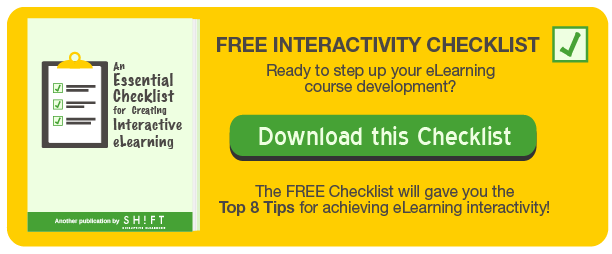How do you design a course that is learner-friendly, engaging, and at the same time supports your training goals? Understanding how the mindworks during learning is basic. More than anything, building eLearning courses requires the ability to be effective.
Whether you're an eLearning developer or a HR Manager or Trainer, knowing the building blocks of eLearning design is a must. Based on the article "More than Just Eye Candy: Graphics for eLearning" let's discuss the 5 essential elements that make up an effective eLearning course design:
Element 1: Add Graphics to Words to Improve Learning

High quality visuals are powerful. According to some studies, this technique can increase retention levels up to 89%, compared to using only text. Truth is we remember images, we forget words. Why? 50-80% of our brain’s natural processing power is devoted to processing sight, (Impressive huh?). Additionally, including visuals in your courses adds meaning to content, enhances motivation and provides aesthetic appeal.
Element 2: Align Text Near Relevant Graphics
 Another element you might want to consider in your eLearning courses is to align images and related text near each other on the screen, particularly if you have multiple images in a same slide or module.
Another element you might want to consider in your eLearning courses is to align images and related text near each other on the screen, particularly if you have multiple images in a same slide or module.
By placing text and related images together, learners use less working memory to relate them. With this practice you can easily improve retention of information by a 68%.
Just make sure you’re including graphics that are relevant to the text. It’s proven there’s a learning gain of over 80% in courses that use graphics that are relevant to the content.
Element 3: Explain Graphics with Audio
 Audio is also an important element in eLearning. Including audio to your courses may increase the effectiveness of the learning experience up to 80%.
Audio is also an important element in eLearning. Including audio to your courses may increase the effectiveness of the learning experience up to 80%.
Embrace audio especially when you need to narrate complicated graphics, instead of using text to explain the image. The tone and style are important elements to consider. For example, by employing a conversational tone and/or speaking in first and second person you enhance learning.
Element 4: Keep the Human Side
 While eLearning has a technological foundation, we must not forget that our goal and main focus are human beings: students.
While eLearning has a technological foundation, we must not forget that our goal and main focus are human beings: students.
Dumping information and stats on audiences isn’t a good practice. Neuroscience has proven that everything the brain learns is filtered through emotions. Therefore, how we appeal emotions through a course determines learning’s success.
Using learning agents or avatars gives a more human touch to the course in process, as well makes the training more personal, thus improving the learning experience. (Click here to see other ways to give a touch of realism to your eLearning courses).
Element 5: Avoid Distracting Visuals, Audio and Text
 A common strategy to increase student’s interest in a course is to include graphics, animations, videos, sounds and even stories. When designing an eLearning course it’s necessary to keep the difference between education and entertainment.
A common strategy to increase student’s interest in a course is to include graphics, animations, videos, sounds and even stories. When designing an eLearning course it’s necessary to keep the difference between education and entertainment.
There needs to be a balance! Including no graphics at all, or just a few decorative ones here and there isn’t a good eLearning practice. On the other hand, putting together excessive amount of graphics and media everywhere can become very distracting. An excessive combination of visuals, audio and text can distract students from the key message, prioritize irrelevant content.
What did you think? Is not as complicated as it looks, right? Creating effective eLearning is possible and easy! Are you considering using and following these essential elements when designing your courses?









